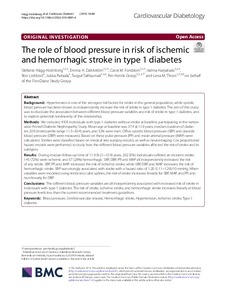The role of blood pressure in risk of ischemic and hemorrhagic stroke in type 1 diabetes
Lena M. Thorn the FinnDiane Study Group; Turgut Tatlisumak; Ron Liebkind; Jukka Putaala; Valma Harjutsalo; Stefanie Hägg-Holmberg; Per-Henrik Groop; Emma H. Dahlström; Carol M. Forsblom
https://urn.fi/URN:NBN:fi-fe2021042823592
Tiivistelmä
Background
Hypertension is one of the strongest risk factors for stroke in the general population, while systolic blood pressure has been shown to independently increase the risk of stroke in type 1 diabetes. The aim of this study was to elucidate the association between different blood pressure variables and risk of stroke in type 1 diabetes, and to explore potential nonlinearity of this relationship.
Methods
We included 4105 individuals with type 1 diabetes without stroke at baseline, participating in the nationwide Finnish Diabetic Nephropathy Study. Mean age at baseline was 37.4 ± 11.9 years, median duration of diabetes 20.9 (interquartile range 11.5–30.4) years, and 52% were men. Office systolic blood pressure (SBP) and diastolic blood pressure (DBP) were measured. Based on these pulse pressure (PP) and mean arterial pressure (MAP) were calculated. Strokes were classified based on medical and autopsy records, as well as neuroimaging. Cox proportional hazard models were performed to study how the different blood pressure variables affected the risk of stroke and its subtypes.
Results
During median follow-up time of 11.9 (9.21–13.9) years, 202 (5%) individuals suffered an incident stroke; 145 (72%) were ischemic and 57 (28%) hemorrhagic. SBP, DBP, PP, and MAP all independently increased the risk of any stroke. SBP, PP, and MAP increased the risk of ischemic stroke, while SBP, DBP, and MAP increased the risk of hemorrhagic stroke. SBP was strongly associated with stroke with a hazard ratio of 1.20 (1.11–1.29)/10 mmHg. When variables were modeled using restricted cubic splines, the risk of stroke increased linearly for SBP, MAP, and PP, and non-linearly for DBP.
Conclusions
The different blood pressure variables are all independently associated with increased risk of stroke in individuals with type 1 diabetes. The risk of stroke, ischemic stroke, and hemorrhagic stroke increases linearly at blood pressure levels less than the current recommended treatment guidelines.
Kokoelmat
- Rinnakkaistallenteet [19218]
